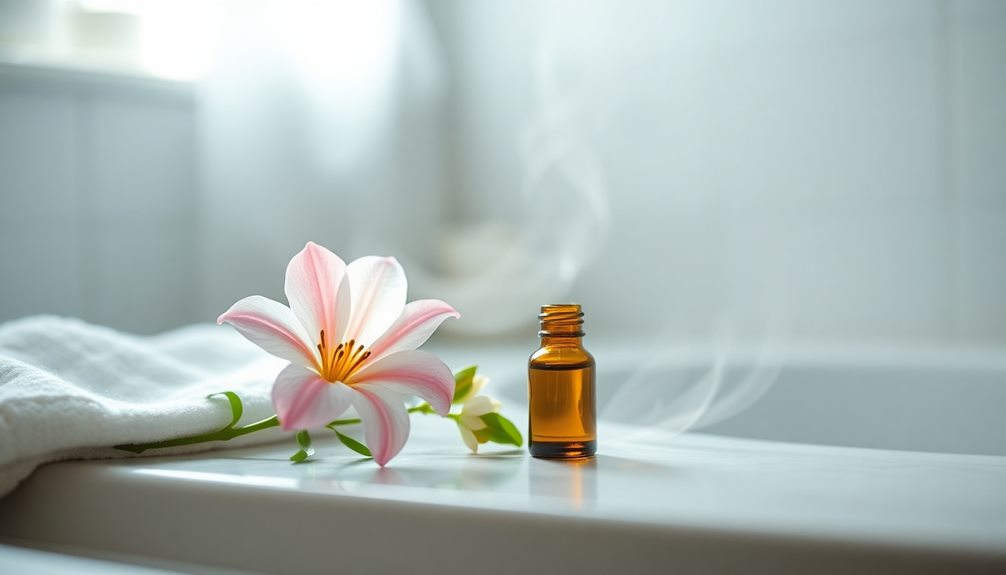If you think you have a vaginal yeast infection, you might notice a mild, sweet smell. Many describe it as being similar to honey or even beer. Typically, there's little to no odor, but any scent you do catch is likely to be gentle. Keep an eye out for thick, white discharge that looks like cottage cheese. Remember, strong or fishy odors aren't normal with yeast infections and may mean something else, like bacterial vaginosis. If you have concerns, it's a good idea to consult a healthcare professional. You'll find more helpful tips on keeping your vaginal health in tip-top shape!
Key Takeaways
- Yeast infections typically produce a mild, sweet scent, often resembling honey or beer.
- Discharge associated with yeast infections is thick, white, and resembles cottage cheese, usually odorless.
- Strong or foul odors are not typical for yeast infections and may indicate bacterial vaginosis.
- Maintaining good hygiene and a balanced lifestyle can help prevent yeast infections.
- Consulting a healthcare professional is essential for unusual smells or persistent symptoms.
Introduction

Vaginal yeast infections are a common issue that many women experience at some point in their lives. These infections happen when there's an overgrowth of yeast in the vagina, which can throw off the natural balance of bacteria.
While you might expect an unpleasant odor, yeast infections typically produce a mild or sweet scent. Some women even compare it to the smell of bread or beer.
The discharge linked to a yeast infection is usually thick and white, resembling cottage cheese. This can also affect the overall scent but usually doesn't lead to a strong or foul smell.
If you notice an unusual odor, especially one that's strong or fishy, it could indicate bacterial vaginosis instead. It's important to pay attention to these signs because they can help you maintain your vaginal health.
If you experience symptoms like itching or changes in discharge along with a noticeable odor, it's a good idea to seek medical evaluation. Getting the right diagnosis will ensure you receive the appropriate treatment and help you restore the balance of bacteria in your vagina.
Description of the Smell

The smell associated with a yeast infection often surprises many women, as it tends to be mild and somewhat sweet. You might notice an odor that's similar to honey or even beer.
This gentle scent differs from the strong, unpleasant smell that often comes with bacterial infections like bacterial vaginosis. When you think of vaginal yeast, it's important to remember that the discharge is usually thick and white, resembling cottage cheese, and is often odorless.
If you do notice an unpleasant smell, it may signal another type of infection rather than just a yeast infection. Keep in mind that while a yeast infection might come with itching, burning, and irritation, odor isn't typically a main sign.
If you experience these symptoms along with a noticeable smell, it's a good idea to consult a healthcare professional for an accurate diagnosis. Your health is important, and understanding these signs can help you take better care of yourself.
If you suspect a yeast infection, don't hesitate to seek advice to ensure you get the right treatment and support.
Source and Composition

Yeast infections stem from an overgrowth of Candida fungus, which normally resides in the vagina in small amounts. When this fungus grows too much, it can disrupt the balance of your vaginal flora, leading to yeast infections.
You might notice thick, white vaginal discharge that looks like cottage cheese, and while yeast infections usually produce little to no odor, some people describe any odor as sweet or beer-like.
It's important to remember that a strong or foul odor isn't typical for yeast infections. If you do notice a bad smell, it might signal another issue, like bacterial vaginosis. This condition occurs when healthy bacteria get out of balance, resulting in irritation and unpleasant odors.
For your peace of mind, if you experience any unusual smells or symptoms, it's always a good idea to consult a healthcare professional. They can help determine the cause and provide the right treatment.
Keeping your vaginal area healthy is key, so pay attention to any changes and trust your instincts when it comes to your body!
Typical Scenarios or Environments

Certain scenarios can increase your risk of developing a yeast infection. For instance, spending a lot of time in moist areas, like wearing tight clothing or wet swimwear, can create a perfect environment for yeast to grow.
When yeast overgrows, it may lead to symptoms like itching and thick white discharge that resembles cottage cheese.
Hormonal changes, such as those during your menstrual cycle or pregnancy, can also play a role. If you've recently taken antibiotics, they might disrupt your natural balance, increasing the likelihood of a vaginal yeast infection.
While a yeast infection typically doesn't have a strong fishy odor, some might notice a mild, sweet scent instead.
Maintaining good hygiene is essential. Try to keep the genital area dry and clean, as moisture encourages yeast growth.
If you notice any unusual vaginal odor or discomfort, it's a good idea to consult a healthcare professional.
Emotional or Cultural Associations

Vaginal health is often surrounded by misconceptions and cultural stigmas that can significantly impact how individuals perceive themselves and their experiences. Many people may feel shame or embarrassment when dealing with vaginal odor, especially during yeast infections. This stigma can lead to emotional responses like anxiety and fear of judgment, making it harder to seek help.
In some cultures, there's a belief that vaginal infections are linked to poor hygiene, which only adds to the pressure. You might worry that others will think you're unclean or even promiscuous if they notice any odor. These thoughts can create stress that affects your mental well-being.
It's essential to remember that normal vaginal odors vary and can even change due to infections. The historical narrative around women's health often pathologizes these natural scents, damaging your body image and self-esteem. Many factors, such as diet, menstrual cycles, and hormonal fluctuations, can contribute to vaginal scent variations, all of which are a natural part of your body’s unique chemistry. It’s important to approach these changes with an understanding that not all variations indicate a problem, and trusting your body is key to maintaining a healthy perspective. By normalizing conversations about vaginal scent variations, we can help dismantle the stigma that often surrounds women’s health and promote body positivity.
Understanding that yeast infections are common and manageable is vital. You shouldn't have to feel alone or ashamed. Open conversations about vaginal health can help break down stigma, allowing for better education and emotional support. You deserve to feel confident and informed about your body!
Health or Safety Considerations

When dealing with a vaginal yeast infection, it's important to understand that strong odors typically aren't a sign of this condition. Yeast infections usually produce a mild, yeasty smell, and the discharge is often thick and white, resembling cottage cheese, without any foul odor.
If you notice a strong or unpleasant smell, it might indicate a different issue, like bacterial vaginosis.
To keep your vagina healthy, maintaining a balanced lifestyle is key. Hormonal changes, diet, and hygiene practices can all affect your vaginal microbiome and possibly lead to odor.
Preventing yeast infections involves being aware of these factors. If you experience unusual vaginal discharge or persistent symptoms, consulting a healthcare provider is crucial. They can provide medical advice for accurate diagnosis and effective treatment of vaginal infections.
Final Thoughts

Understanding the nuances of vaginal health can empower you to better recognize and address any concerns.
A vaginal yeast infection usually doesn't create a strong odor. If you notice an odor, it's often mild, with a sweet or yeasty quality. The discharge from a yeast infection is typically thick and white, similar to cottage cheese, and is generally odorless.
However, if you experience a strong or unpleasant smell, it may indicate bacterial vaginosis or another type of infection. In such cases, it's important to seek a medical evaluation.
Remember, while some yeast infections might've a subtle smell, significant foul odors can signal a different issue.
You can help prevent the overgrowth of yeast by maintaining good vaginal hygiene and following a balanced diet. This simple practice not only helps keep your vaginal health in check but also reduces any potential odors.
Always listen to your body. If you notice changes like thick discharge or strong smells, don't hesitate to consult a healthcare professional. Taking these steps can make a big difference in your overall vaginal health and well-being.
Frequently Asked Questions
Do Yeast Infections Have an Odor?
Yeast infections typically don't have a strong odor. If you notice a mild smell, it might be sweet or yeasty, but it's not a primary sign. Strong odors usually indicate a different issue, like bacterial infection.
How Do You Tell if You Have BV or a Yeast Infection?
To tell if you have BV or a yeast infection, pay attention to symptoms. BV typically has a fishy odor and thin discharge, while a yeast infection causes intense itching and thick, white discharge.
What Does BV Smell Like?
Bacterial vaginosis typically smells fishy, especially after sex or during your period. If you notice this odor along with a thin, gray discharge, it's best to consult your healthcare provider for advice and treatment.
Why Do I Smell Fishy After He Came in Me?
If you smell fishy after intercourse, it could be due to bacterial vaginosis, which happens when your vaginal bacteria are out of balance. Consider consulting a healthcare provider for a proper diagnosis and treatment options.









